#arslan tash
Text

Relief of Ram-Headed Sphynxes
Frieze gifted by Aramean King Hazael to the King of Assyria
Arslan Tash
Aleppo, Syria
c. 600 BCE
Housed in Syria-Aleppo Museum
46 notes
·
View notes
Text



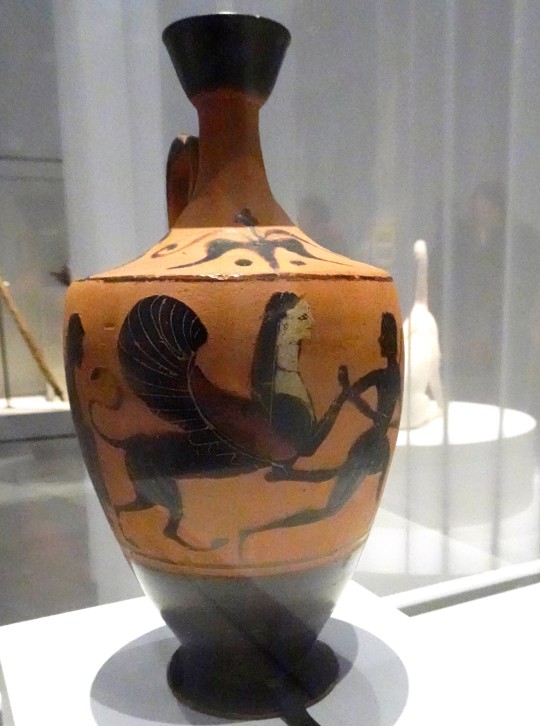
Il y a une petite quinzaine, je suis allé avec Julien et Katie, au Louvre-Lens pour une expo temporaire : “Animaux Fantastiques”. Une très belle expo ! Ici des sphinx (et des sphinges)
plaques de meubles en ivoire: à gauche, sphinx - Syrie maritime, 1500-110 av. J-C. ; à droite, sphinx - palais d'Arslan Tash, Syrie, 700 av. J-C.
orthostate (pierre de soubassement de temple), sphinge ailée - Guzana, Syrie, 900 av. J-C.
pectoral en or, avec sphinx - Enkomi, Chypre, 1200-1000 av. J-C.
lécythe, sphinge poursuivant un jeune homme - Athènes, 550 av. J-C.
#expo#louvre-lens#animaux fantastiques#créature#monstre#shinx#sphinge#syrie#ivoire#arslan tash#orthostate#guzana#pectoral#or#enkomi#chypre#lécythe#grèce antique#athènes
9 notes
·
View notes
Photo
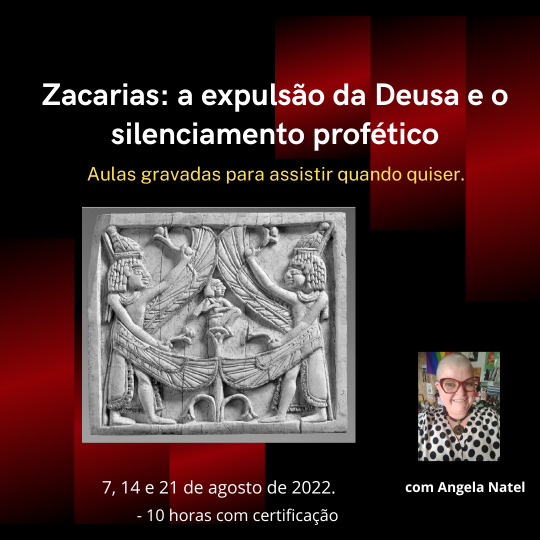
Curso: “Zacarias: a expulsão da Deusa e o silenciamento profético”.
Carga horária: 10 horas com certificação
7, 14 e 21 de agosto de 2022 – aulas gravadas para assistir quando quiser.
Conteúdo
Neste curso iremos examinar, capítulo a capítulo, o livro profético Zacarias, da Bíblia Hebraica (Antigo Testamento), sob uma perspectiva sócio histórico-crítica indiciária, com ênfase no entendimento das visões descritas no livro e sua relação com a retirada da imagem da Deusa Asherah do Templo de Jerusalém e a censura às suas sacerdotisas, o silenciamento e as violências sofridas pelas profetisas a partir da instituição da monolatria por parte da elite sacerdotal judaíta pós exílica.
Trabalharemos as simbologias e elementos linguísticos, com apoia da análise historiográfica a respeito dos conflitos que resultaram no completo silenciamento da história dessas mulheres em torno da Deusa Asherah, bem como da atividade profética que destoava da ideologia sacerdotal. Além disso, serão trabalhados os mitos elaborados na manutenção dessa ideologia, como as narrativas de Elias e as demais retroprojeções nos textos “históricos” do Antigo Testamento, dentro do contexto de sua redação, bem como as mitologias que circundam as narrativas e que, por vezes, são desconhecidas dos leitores que acessam apenas traduções dos textos que foram escritos, a princípio, em língua hebraica.
Métodos de ensino e aprendizagem
- 9 horas de aulas ao vivo (que serão gravadas para acesso dos alunos) distribuídas em 3 momentos de 3 horas cada em estilo de conferência ao vivo, mais orientação de leitura e análise dos textos para atividades entre as aulas, mais discussão em grupo.
- Plataforma online com material de leitura, aulas gravadas para guiar os alunos através do material de leitura que será fornecido.
O curso inclui:
- Atendimento personalizado.
- Certificado de conclusão.
Pré-requisitos:
Ter acesso à internet.
Todos os que adquirirem o Curso: “Zacarias: a expulsão da Deusa e o silenciamento profético” concorrerão ao livro "Metodologia do Antigo Testamento", de Horácio Simian-Yofre (org.), que será sorteado dia 28 de agosto em live às 17h em meu Instagram (angelanatel007).
Garanta já seu ingresso e venha para o Curso: “As visões de Zacarias: quando a Deusa, as profetisas e as sacerdotisas silenciaram”.
https://www.sympla.com.br/zacarias-a-expulsao-da-deusa-e-o-silenciamento-profetico__1637702
Imagem: Placa de marfim, Arslan Tash, século oitavo AEC. Museu do Louvre, Paris. Raphael Chipault / Art Resource, NY.
0 notes
Text
A Divine Contract for Household Protection (Arslan Tash Amulet 1)
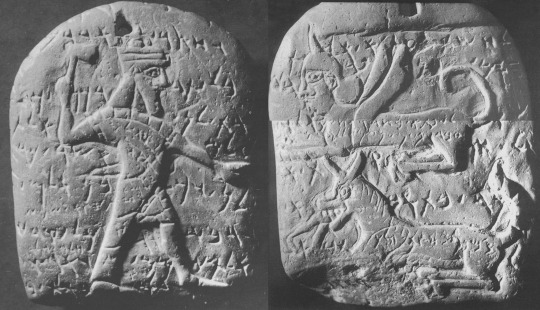
This amulet plaque was found in Arslan Tash, near the northern border of Syria; it’s about the size of a business card. Although its authenticity has been disputed in the past, the current consensus says that it’s probably a real artifact from the 7th or 6th century BCE.
Written in Phoenician, using an Aramaic script, the amulet wards female demons away from the house. Some of them (the ʿPTʾ) may have been flying demons represented by the sphinx on one side; the wolf, halfway through devouring a human, may be the demonic “lamb-strangler.” The warrior on the other side may have been Ashur, Baal, or Horon, all warrior gods mentioned in the text.
As an incantation against flying female demons who attack the household at night, this amulet may connect to ancient Near Eastern traditions of Lilith/Lamashtu; the word “lilith” may even appear, but only half of it is visible. The two sides of the amulet may represent a cosmic gender duality: male violence, which is godlike and protective, as compared to female violence (the sphinx and the devouring she-wolf), which is dangerous and disruptive. The literary motifs of darkness and light parallel these themes. Without better textual consensus or iconographic parallels, though, the amulet’s precise readings are still uncertain.
Main Text
An incantation against ʿPTʾ,
a contract of Sasmi son of PDRŠ:
uphold it for him
and against the Lamb-Strangler(s)!
The house I enter, you shall not enter,
and the courtyard I walk, you shall not walk.
They have sworn an eternal contract with us.
Ashur swore to us,
and all the deities, and the chief of the multitude of the sacred,
an eternal contract with heaven and earth —
with the contract of Baal, lord of the earth;
with the contract of the wife of Horon, whose speech is true,
and his seven concubines,
and the eight wives of holy Baal.
On the Sphinx and Wolf
Against ʿPTʾ:
From the dark room, move onward;
Go quickly, quickly tonight; [1]
From my house at midnight, go!
On the Warrior
… to my door,
and light to the doorposts;
the sun rises […]
[1] “Tonight” is partially broken and may, instead, be reconstructed as “Lilith”: “Go quickly, quickly, o Lilith!”
306 notes
·
View notes
Link
22 notes
·
View notes
Text
““Half of me is beautiful
but you were never sure which half.”
— Ruth Feldman, “Lilith”
Below the read more is an interesting scholarly article about Lilith by Rabbi Jill Hammer
Lilith is the most notorious demon in Jewish tradition. In some sources, she is conceived of as the original woman, created even before Eve, and she is often presented as a thief of newborn infants. Lilith means “the night,” and she embodies the emotional and spiritual aspects of darkness: terror, sensuality, and unbridled freedom. More recently, she has come to represent the freedom of feminist women who no longer want to be “good girls.”
The story of Lilith originated in the ancient Near East,where a wilderness spirit known as the “dark maid” appears in the Sumerian myth “The descent of Inanna” (circa 3000 BCE). Another reference appears in a tablet from the seventh century BCE found at Arslan Tash, Syria which contains the inscription: “O flyer in a dark chamber, go away at once, O Lili!”
Lilith later made her way into Israelite tradition, possibly even into the Bible.Isaiah 34:14, describing an inhospitable wilderness, tells us: “There goat-demons shall greet each other, and there the lilit shall find rest.” Some believe this word “lilit” is a reference to a night owl, and others say it is indeed a reference to the demon Lilith. A magical bowl from the first century CE, written in Hebrew, reads:” Designated is this bowl for the sealing of the house of this Geyonai bar Mamai, that there flee from him the evil Lilith…” Ancient images of Lilith which show her hands bound appear to be a form of visual magic for containing her.
In the Talmud, Lilith becomes not only a spirit of darkness,but also a figure of uncontrolled sexuality. The Babylonian Talmud (Shabbat151a) says: “It is forbidden for a man to sleep alone in a house, lest Lilith get hold of him.” Lilith is said to fertilize herself with male sperm to give birth to other demons.
In Genesis Rabbah, we encounter a brief midrash that claims that Adam had a first wife before Eve. This interpretation arises from the two creation stories of Genesis: InGenesis 1, man and woman are created at the same time, while inGenesis 2 Adam precedes Eve. The rabbinic tale suggests that the first creation story is a different creation, in which Adam has a wife made, like him, from the earth. For some reason this marriage doesn’t work out,and so God makes Adam a second wife, Eve.
In the ninth or tenth century, a clever collection of legends titled the Alphabet of Ben Sira draws on earlier stories of Adam’s wife, and of Adam’s coupling with demons, and spins an elaborate story in which Lilith is Adam’s first wife:
“When the first man, Adam, saw that he was alone, God made for him a woman like himself, from the earth.God called her name Lilith, and brought her to Adam. They immediately began to quarrel. Adam said: “You lie beneath me.” And Lilith said: “You lie beneath me! We are both equal, for both of us are from the earth.” And they would not listen to one another.As soon as Lilith saw this, she uttered the Divine name and flew up into the air and fled. Adam began to pray before his Creator, saying: “Master of the universe, the woman that you gave me has fled.” God sent three angels and said to them: “Go bring back Lilith. If she wants to come, she shall come, and if she does not want to come, do not bring her against her will.“
he Lilith of this story confronts both Adam and God: she defies patriarchy, refuses a submissive sexual posture,and in the end refuses marriage altogether, preferring to become a demon rather than live under Adam’s authority. Notice that Lilith flees to the Sea of Reeds:the place where the Hebrews will one day go free from slavery. In this version of the Lilith story, Lilith becomes what all tyrants fear: a person who is aware she is enslaved.
This version of the Lilith tale in the Alphabet of Ben Sira quickly spread throughout Jewish life, and others expanded on it. The Zohar, a mystical work from 12th century Spain, imagines Lilith not only as the first wife of Adam but also as the wife of Satan. In the Kabbalah, Lilith takes on cosmic power. She is a chaotic counterpart to the Shekhinah (the feminine Divine Presence, the bride of the Infinite). In fact, the Zohar imagines that while the Jews suffer in exile, the Holy One (the masculine aspect of the Divine) separates from the Shekhinah, and consorts with Lilith.Lilith’s sexual-spiritual link with the Divine will only end when the Messiah comes and the brokenness in the world is mended.
In folk Judaism, the primary myths about Lilith continue to identify her principally as a stealer of babies. Numerous amulets for pregnant women and babies from medieval through modern times use the three names of the angels mentioned in the Alphabet of Ben Sira (Sanvi, Sansanvi, and Samangelof) to ward away Lilith. Such amulets may also contain a circle with the names of Adam and Eve on the inside of the circle, and the name of Lilith on the outside: a clear warning to Lilith to stay outside the family realm. A red ribbon is also sometimes placed on a crib to ward off Lilith.
In the modern period, the tale of the put-upon wife who flees to a place of liberation became a celebrated paradigm. Numerous modern Jewish poets and authors, female and male, wrote accounts of Lilith that use old stories to express new ideas.
Perhaps the best-known of the new Lilith tales is”The Coming of Lilith,” by Judith Plaskow. In this feminist midrash, Lilith flees the garden because she is an “uppity woman” who doesn’t want to be pushed around by Adam or God. However, she misses female companionship.Lilith soon sneaks back into the garden and befriends Eve. Eve has been told Lilith is a demon, but once the two women share their stories, they become allies and companions in the search for knowledge.
Enid Dame, in her poem “Lilith,” imagines Lilith as an eternal bohemian who leaves Eden, drops in and out of men’s sexual fantasies in the Middle Ages, and now lives with a cab driver in New Jersey,where she still cries in the bathroom as she remembers Eden “and the man and the God I couldn’t live with.”
In Lynn Gottlieb’s story of Lilith, Lilith is made from the sky and Adam from the earth. In her love for Adam, Lilith chooses to forget she came from the sky, and she becomes Eve, settled and happy but ignorant of her own true nature. In her story, Gottlieb dramatizes the struggle of women to love men while still loving themselves.
On the other hand, Jacqueline Lapidus’ brief poem”Eden” imagines a lesbian encounter between Lilith and Eve. Using the Lilith legend, Lapidus invents an origin story for love between women. Scholar and author Ohad Ezrachi frequently writes about Lilith as a split-off sexual component of women, an image created by men fearful of a full relationship. He encourages men and women to see Lilith and Eve as the same person.
Lilith has become such a popular figure that whole enterprises (like the women’s music concert Lilith Fair and the Jewish feminist journal Lilith Magazine) are named after her. Once a source of fear, Lilith has been transformed into an icon of freedom. While some disapprove of this widespread embrace of a former demon, Lilith’s rehabilitation makes sense. The frightening character of Lilith grew, in part, out of repression: repression of sexuality, repression of the free impulse in women, repression of the question “what if I left it all behind?” As modern Jews begin to ask questions about sex, freedom, and choice more directly, Lilith becomes a complex representation of our own desires.
18 notes
·
View notes
Link
1 note
·
View note
Text
Un tezaur fabulos descoperit la Ziwiya
Un tezaur fabulos descoperit la Ziwiya
Într-o inscripţie din al şaselea an al domniei sale, Sargon al II-lea declară că a incendiat Izirtu, capitala ţării mameenilor şi că a pus mâna pe oraşele Zibia şi Armaid. El spune, vorbind de rebelul Ulusunu, manneean: „Izirtu, oraşul său regal, Izibeia şi Armaid, puternicele sale fortăreţe, le-am luat şi le-am incendiat”.
Sargon al II-lea cu un demnitar. Bazorelief de pe un perete din…
View On WordPress
#Armaid#Arslan Tash#Asiria#Assurbanipal#capitala ţării mameenilor#Christos#civilizaţia materială asiro – babiloniană#civilizaţiile asiriană#Darius Achemenidul#descoperit#dezvaluiribiz.ro#Ecbatana#http://www.vrăjitoarero.com/#Izibia#Izirtu#Khorsabad#lacul Urmiya#Manai#manneean#manneeană#perşilor#portalulvrajitoarelor.ro#rasei iraniene#Rusas al II-lea#Sakkiz#Sargon al II-lea#sciţii#Susa#tezaur fabulos#Tezaurul de la Ziwiya
0 notes
Text

Relief of a Woman with Wig and Headdress
Arslan Tash, Syria
c. 2500 BCE
9 notes
·
View notes
Photo
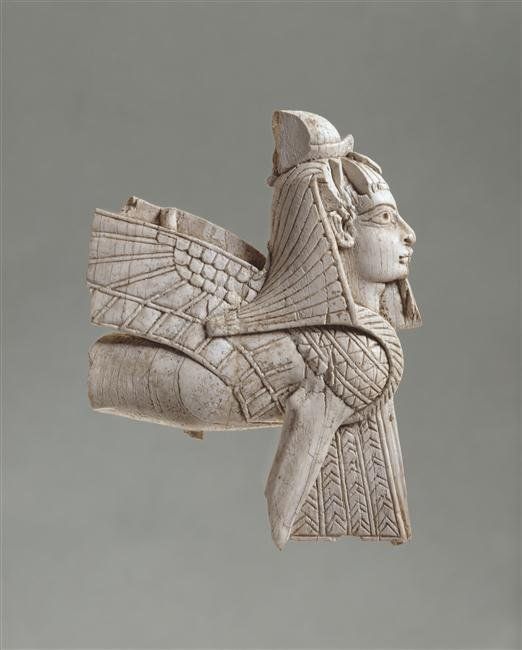
#History: Arslan Tash #sphinx with human head (Egyptian influence), 8th cent. BC https://ift.tt/1B7Y0I0
1 note
·
View note
Photo

Lilith, la primera mujer de Adán
En el libro Génesis, en su primer capítulo que forma parte tanto de la Torá como de la Biblia, se menciona la forma en que Dios creó al “hombre y a la mujer” a su imagen y semejanza. Más en el capítulo posterior, solamente se hace mención de Adán. ¿Dónde se quedó la mujer en el primer capítulo? No es sino hasta el segundo capítulo que Eva fue creada, y hasta el tercero recibe su nombre. Esta inconsistencia sugiere que una parte del texto original fue editada o removida.
Lilith adan y eva
Uno de los registros más antiguos de lo que muchos suponen fue la primera mujer de Adán, Lilith, proviene de los escritos en los amuletos de Arslan Tash, reliquias que datan del siglo 7 a.C. Sin embargo, algunos historiadores dicen que Lilith es mencionada incluso antes de esta fecha, en la demonología sumeria del tercer milenio a.C. En la Epopeya de Gilgamesh, un poema de origen mesopotámico fechado en el 2100 a.C., hay una posible mención de Lilith como un demonio. Es decir, Lilith ya era conocida incluso antes de la compilación del Génesis, lo que refuerza la teoría de que pudieron haberla “borrado de la historia”.
Según lo expuesto en Los manuscritos hebreos de Ben Sira, uno de los textos que dan forma a la colección de escritos rabínicos condensados en el Talmud, Lilith fue creada a partir del barro junto con Adán – por lo tanto, antes que Eva. Pero ella se negó a tumbarse debajo de él a la hora del sexo por no sentirse inferior y, como protesta, terminó abandonando el Edén. Es decir, según el antiguo folclore judaico, Lilith se reveló contra la “superioridad” masculina de Adán, lo que la convierte en una figura realmente problemática para el judaísmo y el catolicismo, religiones tradicionalmente patriarcales.
Otra evidencia extra de que Eva no fue la primara mujer puede encontrarse en los versículos de su creación, en el segundo capítulo de Génesis. En varias de las ediciones del texto, Dios decide dar al hombre una compañera “idónea”, lo que sugiere que previamente se había creado alguna primera compañera “no idónea”. Como refuerzo a esta teoría aparecen las palabras de Adán en algunas versiones de la Biblia (por ejemplo, la versión King James) cuando ve a Eva: “Esta es ahora hueso de mis huesos, y carne de mi carne”.
estatua lilithOtro motivo para que Lilith haya desaparecido del Génesis es de índole histórico. Durante el siglo 7 y 6 antes de nuestra era los hebreos, patriarcas de la tradición judeo-cristiana, fueron exiliados a Babilonia. En aquella época, los babilonios empezaron a adorarla, rindiéndole culto como una diosa de la fertilidad. Como era venerada por sus captores babilonios, los hebreos eliminaron a Lilith del mito de la creación de la humanidad, y subsecuentemente del Génesis judío y católico.
También se hace mención de Lilith en el Libro de Isaías, que forma parte tanto de la Torá como de la Biblia. Sin embargo, a través de las diversas traducciones, su nombre fue tergiversado hasta que lo convirtieron en “animal nocturno” o “lechuza”. Solamente algunas traducciones que se basan en los textos hebreos (más antiguos) conservan a “Lilith” en Isaías 34, en el pasaje donde el profeta describe la forma en que Dios destruirá Babilonia y, en la tierra desolada, Lilith encontrará un lugar para descansar. En otras palabras, el profeta conocía la figura de la “primera mujer”. Textos hebreos y representaciones artísticas describen a Lilith como una mujer alada y serpenteante. De esta forma, podría existir una asociación entre ella y la figura de la serpiente en el Edén.
De forma particular, la Iglesia Católica eliminó definitivamente la única mención de Lilith en la Biblia a mediados del siglo XVI, durante el Concilio de Trento. En este, la Iglesia tomó la decisión de declarar “oficial” la Biblia Vulgata, una traducción al latín del siglo IV que ya había cambiado la palabra “Lilith” en Isaías 34 por «ibis«. Aquella adopción de la Biblia que ya había eliminado a Lilith posibilitó que al poco tiempo fuera desapareciendo de la tradición católica.
Por otra parte.Sin embargo, nada es totalmente cierto cuando se habla de textos antiguos. La teoría académica dominante sobre el Génesis dice que la “incoherencia” entre el primer y segundo capítulo fue producto del intento de integrar dos mitos de la creación en un solo libro, y no hay indicios de que alguna parte de estos fuera “eliminado”. El Génesis está totalmente abierto a la interpretación. Hay quienes leen el primer capítulo como un resumen general de la creación del mundo, para entrar en detalles en el segundo
Tanto Génesis como Isaías son textos antiguos, con orígenes inciertos y que pasaron por diversas traducciones hasta las versiones actuales, que difieren entre sí de diversas formas. Es decir, no existen versiones “definitivas” de estos libros.
Todas las conexiones entre la figura de Lilith del folclore judío y las civilizaciones precristianas son cuestionables. Algunos dicen que los amuletos de Arslan Tash son falsificaciones. El pasaje en la Epopeya de Gilgamesh donde se cita a Lilith podría haberse agregado en el siglo 6 a.C., y su significado es incierto.
El único texto que, de hecho, menciona a Lilith como la primera mujer de Adán es el alfabeto de Ben Sira, del siglo VII, que algunos consideran satírico, aunque forme parte del Talmud judío.
Los textos sagrados no son libros de historia (y ni siquiera en los libros de historia es posible encontrar total precisión). Discutir lo que “verdaderamente” sucedió en el Edén es prácticamente inútil, pues no hay respuesta.
Referencias:
The Epic of Gilgamesh: The Babylonian Epic Poem and Other Texts in Akkadian, Andrew GeorgeHow to Read Genesis, Tremper Longman IIIBibleGatewayBiblioteca PléyadesThe Digital Dead Sea Scrolls
0 notes
Text
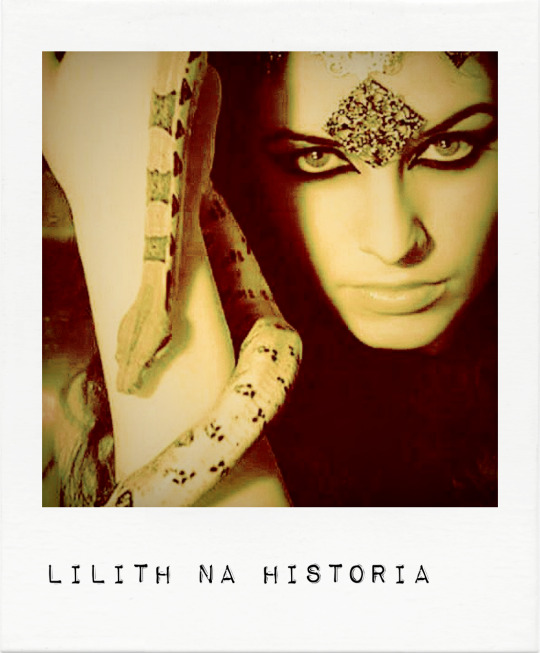
╭❁·❀·───────────────────────────
╰► :🐻☁️: ❭──• i n t r o d u ç ã o ;
───────── • ⊰
┊ ┊ ┊
┊ ┊ ┊
┊ ┊ ✤
┊ ✩
✦
🌙 *Mesopotâmia*
A história de Lilith começa na antiga Mesopotâmia,
onde era uma deusa dos ventos e das tempestades.
Por associação com outras entidades do mesmo tipo e
com atributos similares, podemos dizer com grande
certeza que seria entidade portadora de doenças e da
morte.
Seria uma entidade tão temida que a tradição
judaica a considerou um demônio, deixando como um
aviso de geração em geração como referência de um
tempo há muito esquecido.
*Gilgamesh*
Uma Referência mais antiga e realmente validada
a Lilith encontra-se epopeia de Gilgamesh, que
começou ser escrita XX a.C. e teve a sua primeira
compilação de todas as lendas e poemas do herói no
século VII a.C. pelo rei Assurbanípal. Lilith é referida
propriamente na parte onde fala de Inanna e da árvore
de Huluppu.
Gilgamesh é o primeiro a fazer jornada do herói
que existe registo literário. Viaja a volta ao mundo,
conquistando e matando criaturas malignas tudo isto
pela busca mais antiga da humanidade: a imortalidade.
Inanna é deusa do amor, fertilidade, beleza,
guerra e desejo sexual. No seu jardim nas margens do
rio Eufrates ela cuidava da árvore Huluppu que tinha
intenções de usar para fazer um trono e uma cama
para si.
Contudo, quando a árvore cresceu, ficando forte e
robusta, três criaturas se mudaram para viver nela. A serpente que não podia ser encantada, se mudou para
a sua base. O pássaro Imdugud construiu o seu ninho
no seu topo, e no tronco da árvore Lilith fez a sua
habitação.
Gilgamesh vai em auxílio de Inanna, golpeando a
serpente que não podia ser encantada. Afugentando o
Pássaro Imdugud, destruído a casa de Lilith fazendo ela
realize uma retirada para o deserto.
*Arslan Tash*
Em 1933 foi descoberto em Arslan Tash, na Síria,
um dos primeiros encantamentos para afastar Lilith
numa placa de pedra calcária, datada do século
VII/VIII a.C. provavelmente seria utilizado como
talismã pendurado contra os ataques dela. Novamente
temos aqui paralelo com outras entidades similares
como caso de Pazuzu.
*Isaías*
Lilith ao longo dos anos foi tornando cada
mais conhecida, XII séculos depois da epopéia de
Gilgamesh ter começado ser escrita, ela aparece no
Livro de Isaías, o profeta que teria vivido no início do
século VIII a.C. referir-se a Lilith com desdém, mais exatamente desta forma;
“E as feras do deserto se encontrarão com hienas;
e o sátiro clamará ao seu companheiro; e Lilite pousará
ali, e achará lugar de repouso para si.” Isaías 34:14
Em algumas das versões do livro de Isaías
atualmente publicadas a referência a Lilith foi
removida. Uma coisa que podemos entender pela
forma como Lilith é mencionada é que ela era
extremamente famosa já que nenhuma explicação da
sua identidade foi acrescentada.
*Pergaminhos do Mar Morto*
Esta é única vez que é mencionada no Antigo
Testamento. Contudo, ela ressurge nos Pergaminhos
do Mar Morto que foram descobertos em Qumran em
1947, escritos possivelmente no século II a.C. Onde
existe um encantamento contra as forças demoníacas.
Mas de igual forma nenhuma explicação é adicionada.
Por estes pontos, podemos entender que ela era
perfeitamente conhecida e temida pela população, em
geral.
*Talmud Babilônico*
Na edição final Talmud Babilônico terminada no
Século VI os rabinos fornecem mais algumas
informações sobre Lilith, estabelecendo aqui
possivelmente a primeira ligação oficial com Succubus.
*Harvard*
Existe uma tigela que faz parte do espólio do
Museu da Universidade de Harvard que tem uma
conjuração contra Lilith para afastá-la das mulheres.
Uma das coisas presentes nas traduções mais antigas,
não era só medo de poderem ser mortos por demônios
durante o sono, mas também gerar uma descendência
demoníaca.
*O Alfabeto de Ben Sira*
Escrito possivelmente
entre o século VIII e XXI no capítulo 5 apresenta aos
judeus medievais uma Lilith muito mais poderosa e
com forte desejo por Sexo. Aqui temos o que marcou
mudança da história da entidade. Hoje em dia se ela
tão famosa, é pelo fato de ter sido acrescentado este
pormenor.
No capítulo 5 do alfabeto é relatado que Ben Sira é
chamado a corte do rei Nabucodonosor da Babilônia para curar o filho que está doente. Depois de ritual de
cura ser realizado, é relatado a história de como anjos
chamados para o ritual viajam pelo mundo subjugando
os maus espíritos (entre eles Lilith), que causam
doenças e morte.
Ben Sira adicionou a versão Genesis uma nova
parte entre criação de Adão e Eva. O Todo-Poderoso
criou da mesma terra de Adão uma mulher, da qual
recebeu o nome de Lilith.
Rapidamente o casal humano começa a brigar,
parecer que tudo se deve com fato de Lilith se recusar
a deitar debaixo de Adão durante o ato sexual.
Contudo, ele insiste que é o seu lugar de direito. Ele
aparentemente acredita que Lilith deveria submissa e
desempenhar deveres de esposa. Lilith, por outro lado,
não está a tentar o dominar. Ela está simplesmente
está a afirmar a sua liberdade pessoal. Lilith afirma:
“Somos iguais porque somos ambos criados da terra”.
Como Lilith e Adão tinham sido formados da
mesma substância é perfeitamente normal que ela
revoltar-se contra o fato de Adão desejar subjugá-la.
Chegou a um ponto em que Lilith cansada de não
conseguir mudar o pensamento de Adão, que ela
recorre à única arma que tinha e pronuncia o nome
Deus. Ao fazer isso ela se torna torna a primeira
pessoa a usar poder da magia.
Graças ao poder do Nome ela ganha asas e se
eleva no ar.
Agora Lilith não é só feita da mesma terra que
Adão, mas também tem o domínio do ar. Viaja até o Mar Vermelho. Lá ela sente-se injustiçada por ter de
sair da sua casa, quando o culpado era Adão que não
compreendia que eles eram seres iguais.
O Criador informa Adão que caso Lilith não volte
para ele, 100 das crianças de Lilith serão mortas por
dia. Para executar sua ordem enviou Três anjos até o
Mar Vermelho para falar com Lilith. Como é lógico ela é
que tinha sido injustiçada, e ainda vieram os anjos
ameaçá-la para voltar para o Éden, a sua raiva apenas
cresceu dentro de si.
Para evitar ser morta pelos anjos, ela usa poder do nome Deus, dizendo que qualquer bebê humano que
use um talismã com nome de Lilith, não vai ser ferido por ela.
O mais provável é que o autor de O Alfabeto de
Ben Sira, tenha inventado a História como uma paródia
a sociedade judaica medieval, já que o texto está
escrito de uma forma muito agressiva.
Apesar desta possibilidade, foi esta mudança que
fez realmente Lilith se tornar famosa na era moderna.
Torna-se hoje como símbolo de classe, poder e da
mulher independente.
*Zohar*
No Zohar que foi compilado pela primeira vez em
Espanha por Moisés de Leão (1250–1305). Existe uma reinterpretação de Gênesis 1:27 que passa de “Ele o
criou” para o plural “Ele os criou”
, fazendo acreditar
que o primeiro modelo do homem original era um ser
andrógino, e a sua divisão deu origem a Adão e Lilith.
Contudo, a parte feminina teria ficado agarrada a Adão,
então o Criador teria colocado Adão num sono profundo
e lhe tenha formado Eva da parte feminina que tinha
ficado com Adão. Lilith quando viu outra mulher
agarrada ao Adão teria saído de casa.
Esta parte propriamente não me dá confiança,
sobretudo porque é a mistificação do assunto e
baseado numa possível mudança de pronome. Uma
coisa que sabemos sobre os rabinos que fazem as
transcrições ao longo dos séculos é que eles eram
extremamente meticulosos em suas reproduções.
O Zohar continua acusando Lilith como nas antigas
versões desde quase da antiguidade como uma sedutora de homens, usando sua semente para gerar
espíritos malignos e causadores de doenças.
Novos capítulos são acrescentados à existência de
Lilith. Aqui ela tenta seduzir o rei Salomão se
disfarçando da poderosa Rainha de Sabá. Relato que
continua aqui, temos o rei a espiar suas pernas. Como
vê que as suas pernas são muito peludas, conclui ela é
Lilith disfarçada.
Último capítulo que é acrescentado à existência de
Lilith é que ela forma casal com Sammael, este por sua
vez é associado com a serpente do éden e com o Líder
dos Anjos Caídos.
Depois disto se espalha como fogo das
bruxas por toda Europa medieval, sendo várias
vezes mencionada nos mais diversos contos.
*Fausto*
Entre eles alemão Goethe (1749–1832) refere-se a
Lilith em Fausto. Para quem não sabe, na obra Dr.
Johannes Georg Faust, faz um pacto com demônio
Mefistófeles.
*Dante Rossetti*
Saga de Lilith continua e agora temos Dante
Rossetti (1828–1882) que foi um poeta, pintor e
fundador da Irmandade pré-rafaelita.
Ele descreve um pacto secreto entre Lilith e a
serpente do Éden. Aqui temos uma Lilith que utiliza a
inteligência para fazer com que a serpente lhe
empreste a sua forma física. Assim Lilith se infiltra no
Éden, convence Eva e Adão a comer o fruto proibido.
Na sua Rossetti sua pintura intitulada “Lady Lilith”
podemos ver Lilith como uma mulher extremamente
bonita.
Como podemos ver, ao longo dos Séculos existiu
um grande número de contributos dos mais diferentes
campos para criar a imagem de Lilith que temos atual
de mulher forte, poderosa e independente.
Os aspectos mais sombrios como destruidora,
causadora de pestes e doenças foi esquecido.
Sua origem foi contada aqui como trata-se de uma
biografia, para que fosse possível compreender como
Lilith se tornou naquilo acreditamos hoje. Isto porque
conhecer história da entidade é primeira forma de
começar os processos de trabalhos mágicos. Existem
textos e referências, que não foram colocados aqui,
devido ao facto de o ponto vista mágico não estarem
corretos, ou serem textos fortemente tendenciosos,
atribuindo características ilógicas as entidades. Alguns
praticantes de magia que não tem clarividência, depois
de conhecer a história sentem uma aproximação da
entidade.
Hoje na era moderna existem centenas de autores
sem qualquer tipo de clarividência que falam sobre
Lilith. Muitos acrescentam pormenores, muitas vezes
fruto de mente fértil. Não é o foco dizer que eles estão certos ou errados. Até porque é
importante estar sempre aberto a novos
conhecimentos. Nunca se sabe onde se vai poder
encontrar uma pérola desabedoria.
Fonte*Grimório Lilith por Seigrefrid Willins Ph. D* 🌙
— [✿🖤Meus Estudos✿] - -❀ೃ .
○°•°♡Bom esse foi o meu blog espero que tenham gostando. Que os Deuses nos abençoe sempre!♡°•°○
1 note
·
View note
Link
20 notes
·
View notes
Photo

ʟɪʟɪᴛʜ : (/ˈlɪlɪθ/; Hebrew: לִילִית Lîlîṯ) is a figure in Jewish mythology, developed earliest in the Babylonian Talmud (3rd to 5th centuries). Lilith is a dangerous demon of the night, who is sexually wanton, and who steals babies in the darkness. The character is generally thought to derive in part from a historically far earlier class of female demons (lilītu) in ancient Mesopotamian religion, found in cuneiform texts of Sumer, the Akkadian Empire, Assyria, and Babylonia.In Jewish folklore, from the satirical book Alphabet of Sirach (c. 700–1000) onwards, Lilith appears as Adam's first wife, who was created at the same time (Rosh Hashanah) and from the same dirt as Adam – compare Genesis 1:27. (This contrasts with Eve, who was created from one of Adam's ribs: Genesis 2:22.) The legend developed extensively during the Middle Ages, in the tradition of Aggadah, the Zohar, and Jewish mysticism. For example, in the 13th-century writings of Isaac ben Jacob ha-Cohen, Lilith left Adam after she refused to become subservient to him and then would not return to the Garden of Eden after she had coupled with the archangel Samael. Evidence in later Jewish materials is plentiful, but little information has survived relating to the original Sumerian, Akkadian, Assyrian and Babylonian view of these demons. While the connection is almost universally agreed upon, recent scholarship has disputed the relevance of two sources previously used to connect the Jewish lilith to an Akkadian lilītu—the Gilgamesh appendix and the Arslan Tash amulets. (See below for discussion of the two problematic sources.) In Hebrew-language texts, the term lilith or lilit (translated as "night creatures", "night monster", "night hag", or "screech owl") first occurs in a list of animals in Isaiah 34:14, either in singular or plural form according to variations in the earliest manuscripts. In the Dead Sea Scrolls 4Q510-511, the term first occurs in a list of monsters. In Jewish magical inscriptions on bowls and amulets from the 6th century CE onwards, Lilith is identified as a female demon and the first visual depictions appear.The resulting Lilith legend continues to serve as source material in modern Western culture, literature, occultism, fantasy, and horror.
2 notes
·
View notes
Link
Lilith is a Hebrew name for a figure in Jewish mythology who is generally thought to be in part derived from a class of female demons called Lilitu in Mesopotamian texts. The Gilgamesh appendix and the Arslan Tash amulets are the two sources used to connect the Jewish Lilith to an Akkadian Lilitu. The Hebrew term Lilith first occurs in Isaiah 34:14. In Jewish folklore, from the 8th–10th century work The Alphabet of Ben Sira onwards, Lilith becomes Adam's first wife, who was created at the same time and from the same earth as Adam. This contrasts with Eve, who was created from one of Adam's ribs. Lilith’s legend was greatly developed during the Middle Ages. In a 13th Century writing, Lilith left Adam after she refused to become subservient to him and then would not return to the Garden of Eden after she mated with archangel Samael. She was said to have spoken the secret Holy name of God and transformed herself into an owl to fly from Eden. The name "Lilith" means "screech owl". In some medieval folklore, Lilith does return to Eden as a serpent. She then offers forth the fruit of the Tree of Knowledge to Eve, making her a kind of proto-Sophia or wisdom Goddess. Charles Leland associated Aradia with Lilith. Aradia, says Leland, is Herodias, who was regarded in stregheria folklore as being associated with Diana as chief of the witches. Leland further notes that Herodias is a name that comes from West Asia, where it denoted an early form of Lilith. Gerald Gardner asserted that there was continuous historical worship of Lilith to present day, and that her name is sometimes given to the goddess being personified in the coven, by the priestess. This idea was further attested by Doreen Valiente, who cited her as a presiding goddess of the Craft: “the personification of erotic dreams, the suppressed desire for delights.” In some Traditional covens, Lilith is viewed as the embodiment of the Witches' Goddess. She was said to have embodied herself in the form of Na'amah, the sister of Tubal Cain, and is therefore one of the original sources of Witchblood. Some see this Lilith as the Queen of the Fairies and Grandmother to them as well. One of the old names for the moon is Lilith’s Lantern, as it was said to be the light that Witches met by. Lilith is associated with the moon, owls, and serpents. Prayer Unto the Queen of Succubi by Andrew Chumbly "I bless the Waters of Desire I drink the Fountain White. I call thee Mother Lilith Harlot of the Night. Mine are the Blossoms of Rousing To Bewitch the Moon-Feast round; Unto me thy Daughters Ye Nymphs of Paradise ground. I bless the Waters of Desire I drink the Fountain White. I call thee Mother Lilith Harlot of the Night. By the Mystery of the Bright Moon And the Vessel of Quickening Fire Thy Power is Made Flesh."
10 notes
·
View notes
Text
https://www.ancient-origins.net/artifacts-other-artifacts/arslan-tash-amulets-0014156
0 notes